Protestant liturgy
| Part of a series on |
| Protestantism |
|---|
 |
|
|
Protestant liturgy or Evangelical liturgy is a pattern for worship used (whether recommended or prescribed) by a Protestant congregation or
Types
Communion liturgies
Protestant traditions vary in their liturgies or "orders of worship" (as they are commonly called). Other traditions in the west often called "
Many other
Divine office
The term "Divine Office" describes the practice of "marking the
In
In
Rites
Protestant liturgy and ritual families are primarily influenced by the theological development of the regions.[7]
Western rites
| Extant |
|---|
|
Eastern rites
| Extant |
|---|
|
Liturgical rites by denomination
Different Christian traditions have employed different rites:
Historical Protestantism
Lutheranism
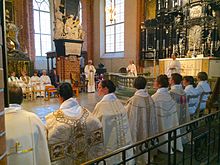
In the parts of North American Lutheranism that use it, the term "Divine Service" supplants more usual English-speaking Lutheran names for the Mass: "The Service" or "The Holy Communion." The term is a calque of the German word Gottesdienst (literally "God-service" or "service of God"), the standard German word for worship.[citation needed]
As in the English phrase "service of God," the genitive in "Gottesdienst" is arguably ambiguous. It can be read as an objective genitive (service rendered to God) or a subjective genitive (God's "service" to people). While the objective genitive is etymologically more plausible, Lutheran writers frequently highlight the ambiguity and emphasize the subjective genitive.[8] This is felt to reflect the belief, based on Lutheran doctrine regarding justification, that the main actor in the Divine Service is God himself and not man, and that in the most important aspect of evangelical worship God is the subject and we are the objects: that the Word and Sacrament are gifts that God gives to his people in their worship.
Although the term
Various forms of the liturgy are used by Lutherans:
- Latin Liturgy of Martin Luther, a form of Pre-Tridentine Mass, based on Formula missae, used mostly in Evangelical Catholic Lutheran and some high church Lutheran churches
- Byzantine riteor known as Divine Liturgy, used by eastern Lutheranism
- German Liturgy of Martin Luther or Deutsche Messe, mostly in western Lutheranism, known as Divine Service among Conservative Lutherans and Holy Communion or The Eucharist among progressive Lutherans
Reformed
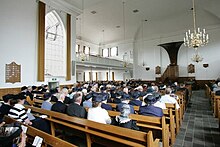
The origins of the liturgy are in
- John Calvin's Order of Worship, or known as Calvinismand some presbyterian churches
- John Knox's Liturgy, based on Book of Common Order, used mostly in Presbyterianism, especially in the Church of Scotland.
Anglicanism
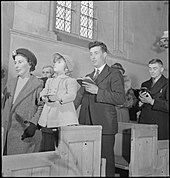
At the time of
The revised edition in 1552 sought to assert a more clearly Protestant liturgy after problems arose from conservative interpretation of the mass on the one hand, and a critique by Martin Bucer on the other. Successive revisions are based on this edition, though important alterations appeared in 1604 and 1662. The 1662 edition is still authoritative in the Church of England and has served as the basis for many of the Books of Common Prayer of national Anglican churches around the world. Those deriving from Scottish Episcopal descent, such as the Prayer Books of the American Episcopal Church, have a slightly different liturgical pedigree.
- Anglican tradition, also known as Anglican rite, based on Book of Common Prayer
- Exhortation and Litany (1544), Protestant predecessor of the Book of Common Prayer
Methodism
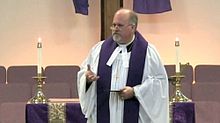

The
there is no Liturgy in the world, either in ancient or modern language, which breathes more of a solid, scriptural, rational piety, than the Common Prayer of the Church of England.[17]
When the Methodists in America were separated from the
The United Methodist Church (the largest Methodist denomination) has official
- Traditional Methodist use, also known as Wesleyan Liturgy, based on The Sunday Service of the Methodists
- Methodist use of 1965, the second liturgical use, based on Book of Worship for Church and Home (1965), was always considered optional and completely voluntary
- United Methodist use, based on The United Methodist Book of Worship
Because John Wesley advocated outdoor evangelism, revival services are a traditional worship practice of Methodism that are often held in local churches, as well as at outdoor camp meetings, brush arbour revivals, and at tent revivals.[20][21][22]
Eastern Protestantism
Byzantine tradition (Eastern European)
- Liturgy of Saint John Chrysostom, used by eastern orthodox churches which accepted the reformation, such as the Evangelical Church of Romania, Evangelical Orthodox Church, and Ukrainian Lutheran Church
Antiochian tradition
- Liturgy of Saint James, West Syriac Rite, used by the Mar Thoma Syrian Church, St. Thomas Evangelical Church of India, and Assyrian Evangelical Church
- Revised Common Lectionary, used by the Believers Eastern Church
Alexandrian tradition
- Liturgy of St. Dioscorus, Ethiopic Rite, principally used by P'ent'aycongregations
Pentecostalism and nondenominational Christianity
Worship service
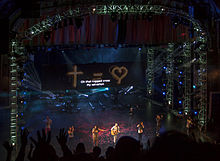
The
- Pentecostal and Charismatic services
While most
- Contemporary service
In the 1980s and 1990s, contemporary Christian music, including a wide variety of musical styles, such as Christian rock and Christian hip hop, appeared in the praise.[31][32][33]
References
- ^ HKT (2021-10-16). "Protestantism". HKT Consultant. Retrieved 2023-02-18.
- ^ Bjorlin, David (2018-06-21). "Hope of the World": the liturgical work and witness of Georgia Harkness".
{{cite journal}}: Cite journal requires|journal=(help) - ^ "Luther's Reform of the Mass". Lutheran Reformation. 2017-03-27. Retrieved 2023-02-18.
- ^ slife (2020-05-20). "Christian Liturgy". The Spiritual Life. Retrieved 2023-02-18.
- ^ slife (2020-05-20). "Christian Liturgy". The Spiritual Life. Retrieved 2023-02-18.
- ^ Fernand Cabrol, "Divine Office" in Catholic Encyclopedia (New York 1911)
- ^ "Evangelical church | Definition, History, Beliefs, Key Figures, & Facts | Britannica". www.britannica.com. Retrieved 2023-02-18.
- ^ See, e.g., John T. Pless, "Six Theses on Liturgy and Evangelism," Archived December 23, 2005, at the Wayback Machine (Conference on Liturgy and Outreach, Concordia College, 1987) ("[I]n worship God is at work to serve His people with His Word and Sacraments. Evangelical worship is Gottesdienst (subjective genitive), Divine service.").
- ^ Article 24 of the Augsburg Confession
- ^ [1][permanent dead link]
- ^ White 1989, p. 68–69.
- ^ Bürki 2003, pp. 33–34.
- ^ White 1989, p. 67.
- ^ White 1989, p. 63.
- ^ F Procter & W. H. Frere, A New History of the Book of Common Prayer (Macmillan, 1905) p. 31.
- ^ Bevan, G. M. (1908). Portraits of the Archbishops of Canterbury. London: Mowbray.
- ^ Works of John Wesley, vol. XVI, page 304
- S2CID 152440716.
- ^ 2008 Book of Discipline paragraph 1114.3
- ISBN 9781630878320.
In addition to these separate denominational groupings, one needs to give attention to the large pockets of the Holiness movement that have remained within the United Methodist Church. The most influential of these would be the circles dominated by Asbury College and Asbury Theological Seminary (both in Wilmore, KY), but one could speak of other colleges, innumerable local campmeetings, the vestiges of various local Holiness associations, independent Holiness oriented missionary societies and the like that have had great impact within United Methodism. A similar pattern would exist in England with the role of Cliff College within Methodism in that context.
- ISBN 9781625849045.
- ISBN 9780802803917.
- ISBN 978-1-5326-5506-7.
- ^ Gerald R. McDermott, The Oxford Handbook of Evangelical Theology, Oxford University Press, UK, 2013, p. 311
- ISBN 978-1-5326-3334-8.
Some have claimed Pentecostals still have no liturgy of their own; however, this study clearly established that the Church of God has a liturgy that has been constantly developing throughout the past 125 years.
- ISBN 978-1-317-05866-3.
The 1911 Constitution and General Rules of the Pentecostal Holiness Church contains a rubric for celebrating the Lord's Supper. It directs the pastor, "at the close of the sermon or Scripture lesson, or at any time that may be deemed proper," to call the deacons to "gather round the table and kneel with the whole congregation" in preparation for the rite.
- ISBN 978-1-77112-141-5.
The service begins with the worship leader and worship team playing a high-energy song intended to signal the transition from this informal greeting time to the worship component of the service. ... After another three or four songs come the announcements and the collection or offering, which are both usually directed by the senior pastor of the congregation. The offering is followed by one or two more subdued worship songs, intended to prepare the worshipers for the sermon. Occasionally, however, the assistant pastor or lay leader within the congregation preaches instead. If it happens to be the first Sunday of the month, the congregation will celebrate communion, which usually follows the sermon, the senior pastor officiating with the assistance of lay leaders.
- ^ Greg Dickinson, Suburban Dreams: Imagining and Building the Good Life, University of Alabama Press, USA, 2015, p. 144
- ISBN 978-1-4185-6857-3.
- ^ Robert H. Krapohl, Charles H. Lippy, The Evangelicals: A Historical, Thematic, and Biographical Guide, Greenwood Publishing Group, USA, 1999, p. 171
- ^ Suzel Ana Reily, Jonathan M. Dueck, The Oxford Handbook of Music and World Christianities, Oxford University Press, USA, 2016, p. 443
- ^ Mathew Guest, Evangelical Identity and Contemporary Culture: A Congregational Study in Innovation, Wipf and Stock Publishers, USA, 2007, p. 42
- ^ Don Cusic, Encyclopedia of Contemporary Christian Music: Pop, Rock, and Worship: Pop, Rock, and Worship, ABC-CLIO, USA, 2009, p. 85-86
